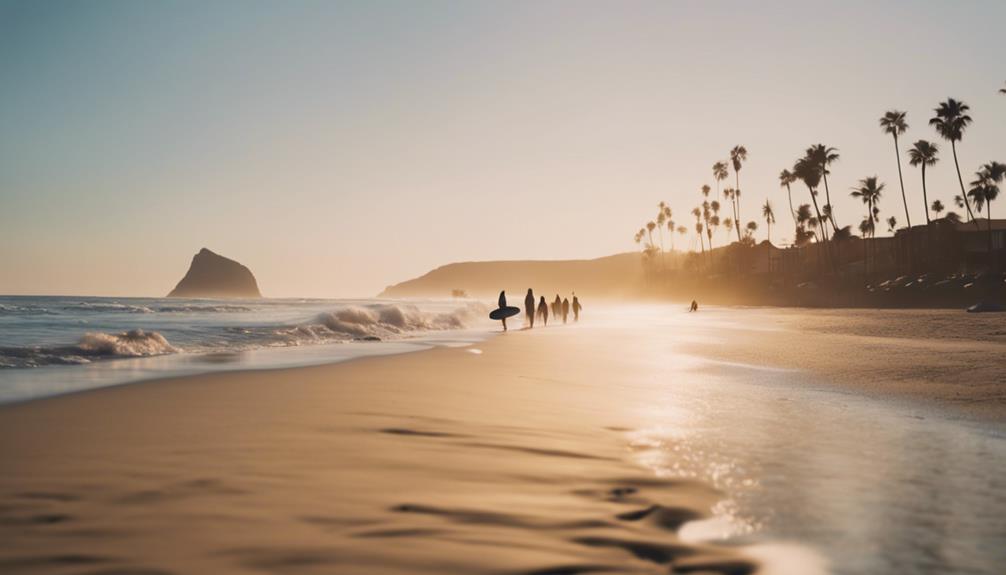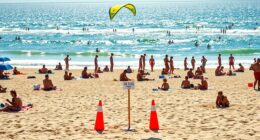When you think about heavy hitters in surfing, you can't miss the monumental waves that define this extreme sport. Waves over 30 feet, like those at Nazaré in Portugal, can reach 100 feet! Spots like Teahupoo in Tahiti and Jaws in Maui also offer jaw-dropping swells. Big wave surfing requires specific gear and training, as the risks are significant, including wipeouts and long hold downs. Pioneering surfers like Garrett McNamara and Maya Gabeira have made history by riding record-breaking waves. Ready to uncover some legendary moments and unique surfing spots? You'll find even more excitement waiting for you.
Key Takeaways
- Nazaré, Portugal is renowned for record-breaking waves, including Sebastian Steudtner's 86-foot ride in 2020 and Garrett McNamara's 100-foot wave in 2013.
- Teahupoo, Tahiti features powerful left-hand barrels breaking over shallow reefs, with Maya Gabeira riding a 73-foot wave in 2020.
- Cortes Bank, California produces legendary swells exceeding 60 feet, with Mike Parsons achieving a remarkable 77-foot ride in 2008.
- Jaws (Peahi) in Maui ranges from 30 to 80 feet and is known for pioneering tow-in surfing techniques.
Characteristics of Big Wave Surfing
Big wave surfing is defined by its towering waves, often exceeding 30 feet, that challenge surfers with their immense power and unpredictability. These powerful and heavy waves require not just courage but also a high level of skill.
As you prepare for surfing huge swells, you'll need to master precise timing for paddling and take-offs. Maneuvering dangerous wave breaks, often located miles offshore, is essential for a successful ride.
Skilled surfers know that the energy generated by these massive waves can be overwhelming. For instance, a 50-foot wave can produce around 1.7 megawatts of energy per meter, emphasizing the sheer force you're dealing with. The risks are significant, too. Violent wipeouts, long hold downs, and even encounters with sharks can occur at popular surf spots like Mavericks and Jaws.
To stay safe, you'll need specialized gear, including inflatable vests and leashes, and often support from jet skis or boats for towing into the waves.
Embracing the challenges of big wave surfing can lead to thrilling experiences, but it demands respect for the ocean's power and the skill to handle its might.
Top Big Wave Surf Spots

When you think of big wave surfing, a few legendary spots come to mind that draw surfers enthusiastic for record-breaking waves.
Each location offers unique wave characteristics that challenge even the most skilled riders.
Let's explore these top big wave surf spots and what makes them stand out in the surfing world.
Legendary Surf Locations
Some of the world's most legendary surf locations, like Nazaré and Teahupoo, draw adrenaline-seeking surfers enthusiastic to conquer their massive waves and challenging conditions. Each big wave surfing spot offers unique thrills and dangers that test your skills and courage.
Here's a snapshot of these iconic locations:
| Surf Spot | Location | Wave Height |
|---|---|---|
| Nazaré | Portugal | Up to 100 feet |
| Teahupoo | Tahiti | 20+ feet (heavy barrels) |
| Jaws (Peahi) | Maui, Hawaii | 60+ feet |
| Mavericks | California | Up to 60 feet |
| Cortes Bank | California | 60+ feet |
At Nazaré, you'll witness record-breaking waves that have captivated surfers worldwide. Teahupoo is infamous for its heavy barrels and treacherous reefs, while Jaws pioneered tow-in surfing for those daring enough to ride its colossal waves. Mavericks is known for its extreme danger, and Cortes Bank, located offshore, boasts massive swells that attract only the most experienced surfers. Are you ready to tackle these legendary surf locations?
Record-Breaking Waves
Record-breaking waves around the world challenge surfers to push their limits and showcase their skills in some of the most exhilarating conditions imaginable. If you're looking for the biggest waves, Nazaré, Portugal, is a must-visit. Here, Garrett McNamara made history with a monumental 100-foot wave in 2013, solidifying Nazaré's reputation as a big wave surfing haven.
Another hotspot is Teahupoo, Tahiti, known for its heavy, hollow waves breaking over a shallow reef. Maya Gabeira's ride of a 73-foot wave in 2020 exemplifies the thrill and danger of this iconic location.
Cortes Bank off California also produces remarkable waves, with heights surpassing 66 feet, famously surfed by Ken Collins during Storm 15 in 2001. Don't overlook Jaws (Peahi) in Maui, where waves range from 30 to 80 feet, recognized for powerful swells and the innovative tow-in surfing pioneered by Laird Hamilton.
Lastly, Mavericks in California presents extreme conditions with waves reaching up to 60 feet, attracting elite surfers enthusiastic to tackle its dangerous reputation. Each of these spots offers a unique big wave surfing experience that pushes the boundaries of the sport.
Unique Wave Characteristics
Across the globe, each top big wave surf spot boasts unique wave characteristics that test surfers' skills and resilience in thrilling conditions. If you're a big wave surfer, you'll want to know what makes these locations truly special:
- Nazaré, Portugal: Swells can exceed 100 feet, thanks to the underwater Nazaré Canyon that channels massive Atlantic waves directly to the shore.
- Teahupoo, Tahiti: Known for its heavy left-hand barrels, this location features powerful waves breaking over a shallow reef, creating a hollow and challenging ride.
Other notable spots like Mavericks in California present steep, fast waves over 60 feet, while Cortes Bank, located offshore, produces legendary waves exceeding 60 feet, ideal for seasoned surfers.
Each of these surf spots demands respect and skill, offering unique challenges that keep big wave surfers coming back for more. Prepare yourself for the adventure of a lifetime!
Notable International Surf Locations
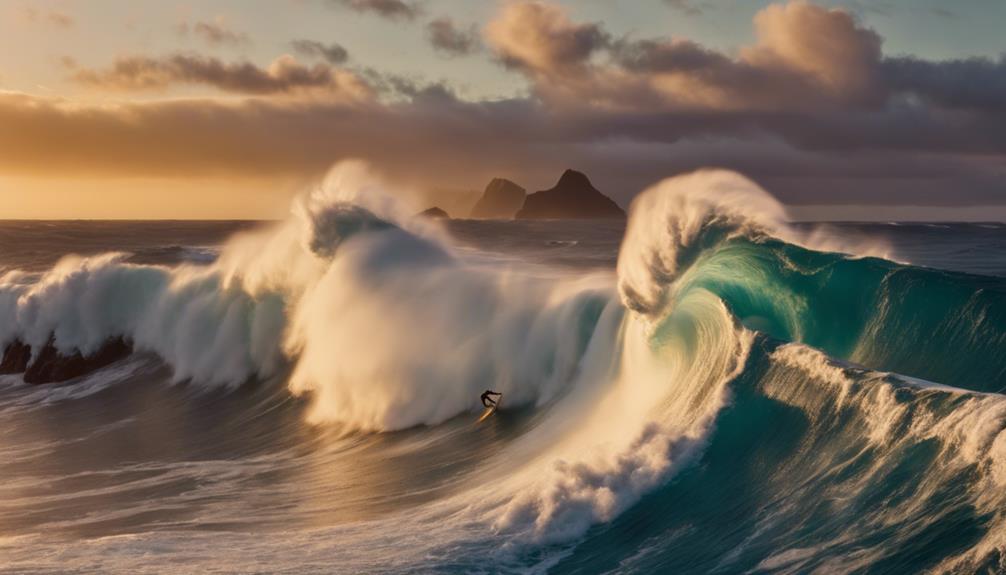
When it comes to notable international surf locations, few places match the thrill and challenge offered by the colossal waves of Nazaré, Portugal, and Teahupoo, Tahiti. Each spot showcases unique characteristics that draw surfers from around the globe, enthusiastic to tackle the biggest waves.
| Location | Wave Height | Notable Features |
|---|---|---|
| Nazaré | 86 feet | Record-breaking waves, big wave surf break |
| Teahupoo | Heavy barrels | Dangerous, shallow reef breaks |
| Peahi (Jaws) | 30-80 feet | Pioneered tow-in surfing |
You can't overlook the legendary Peahi, known for its massive tube rides and innovative surfing techniques. Then there's Mavericks in California, infamous for its extreme danger and great white shark presence, producing waves up to 60 feet. Each of these locations offers a unique challenge and an adrenaline rush that's hard to replicate. Whether you're an experienced surfer or just an admirer, witnessing these locations is a thrilling experience. So, which of these heavy hitters will you add to your surf bucket list?
Preparation Strategies for Surfers

Preparing for the challenge of heavy surf requires careful planning and the right strategies to guarantee safety and success in the water. Here are some key preparation strategies you should consider:
- Gear Selection: Choose high-performance surfboards designed for big waves, impact vests for added safety, and appropriate wetsuits to handle cold water temperatures.
- Training: Engage in continuous training to build strength, stamina, and mental resilience. This preparation helps you meet the intense physical demands of big wave surfing.
Additionally, don't overlook the importance of jet ski support for accessing remote surf breaks. Familiarize yourself with wave characteristics and take-off timing at each location to enhance your wave selection.
This knowledge can greatly reduce your risk of wipeouts and injuries, ensuring a safer experience when tackling heavy surf. By taking these strategies seriously, you'll be better equipped to face the ocean's might and ride those massive waves with confidence.
Historical Context of Big Wave Surfing
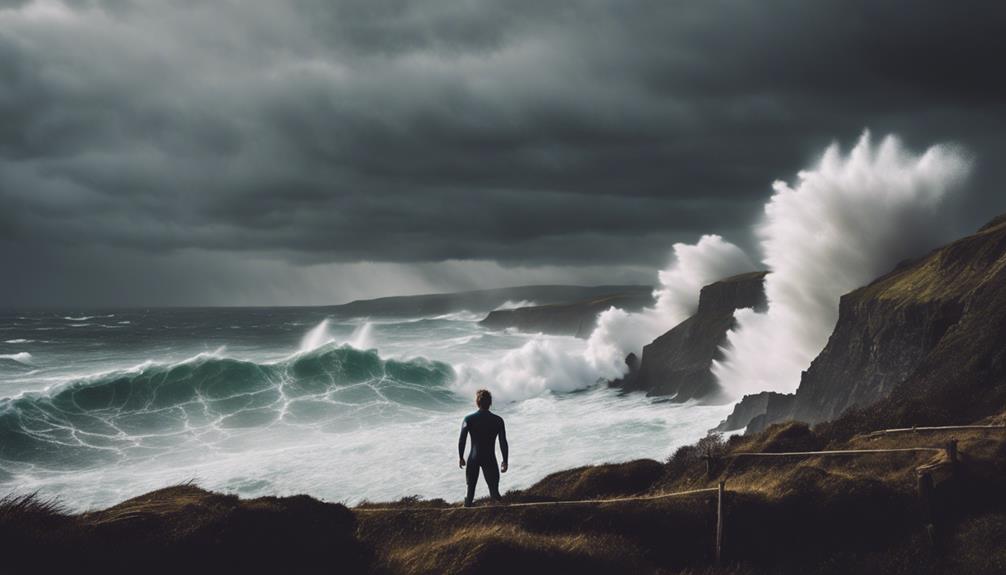
As you explore big wave surfing's rich history, you'll discover the early pioneers who shaped the sport and the techniques they developed.
Key milestones, like record-breaking waves and innovative approaches, highlight the evolution of this thrilling pursuit.
Understanding these points will deepen your appreciation for the challenges and triumphs that define big wave surfing today.
Early Pioneers of Surfing
The early pioneers of surfing, like Duke Kahanamoku, showcased Hawaii's potential for big wave riding, sparking a passion for the sport that continues to grow today. These trailblazers laid the groundwork for what would become a pivotal part of surfing history.
Duke Kahanamoku popularized the sport in the early 20th century.
Greg Noll pushed the limits of big wave surfing in the 1950s and 1960s.
Advancements in surfing technology have greatly improved safety and performance.
As early pioneers, Kahanamoku and his contemporaries not only caught waves but also captivated the world with the thrill of big wave surfing. Kahanamoku's influence helped establish Hawaii as the epicenter of surf culture.
Later, surfers like Greg Noll took on larger waves, challenging themselves and redefining what was possible in the sport.
With each generation, advancements in surfing technology, including lighter materials and better designs, enabled surfers to tackle increasingly massive waves.
These early pioneers set the stage for modern big wave surfing, proving that the ocean's power could be harnessed with skill, courage, and innovation.
Evolution of Techniques
Evolving from simple paddling techniques, big wave surfing has transformed dramatically since the 1950s, enhancing both performance and safety for surfers tackling ever-larger waves.
In the early days, surfers mostly relied on their strength and skill to paddle into waves, but the introduction of tow-in surfing in the 1990s, pioneered by Laird Hamilton at Jaws in Maui, revolutionized the sport. This method allowed surfers to catch massive waves that were previously impossible to ride.
As wave sizes have increased, surfboards have also seen significant advancements in design and materials, providing better control and stability. You'll notice that safety equipment, like inflatable vests and leash technology, has become essential for managing wipeouts and minimizing the risk of drowning in dangerous conditions.
The first recorded session at Nazaré, Portugal, in the mid-2000s marked a turning point in big wave surfing, inspiring surfers to develop specialized techniques tailored to its unique challenges.
Today, it's clear that the evolution of techniques in big wave surfing continues to push the boundaries, allowing you to ride some of the heaviest waves in the world with greater confidence and safety.
Milestones in Record Waves
How did Nazaré, Portugal, become the epicenter for record-breaking big wave surfing, with milestones that continue to reshape the sport's history? You'll find that this stunning location has produced some of the heaviest waves ever surfed, drawing attention from surfers around the globe.
Garrett McNamara rode the largest wave ever at 100 feet (30.8m) in November 2013.
Sebastian Steudtner set the big wave record for the heaviest wave surfed at 86 feet (26.2m) in 2020.
Mike Parsons made waves at Cortes Bank in 2008 with a remarkable 77-foot (23.5m) ride.
These surfing milestones are pivotal in understanding how Nazaré has transformed the landscape of big wave surfing. The sheer power of the ocean here showcases the incredible potential for extreme surfing, inspiring both seasoned and aspiring surfers to push their limits.
While the Indian Ocean Tsunami of 2004 demonstrated nature's might with waves over 100 feet, it's the recreational feats at Nazaré that truly capture the spirit of adventure in the surfing world.
Record Holders at Nazaré
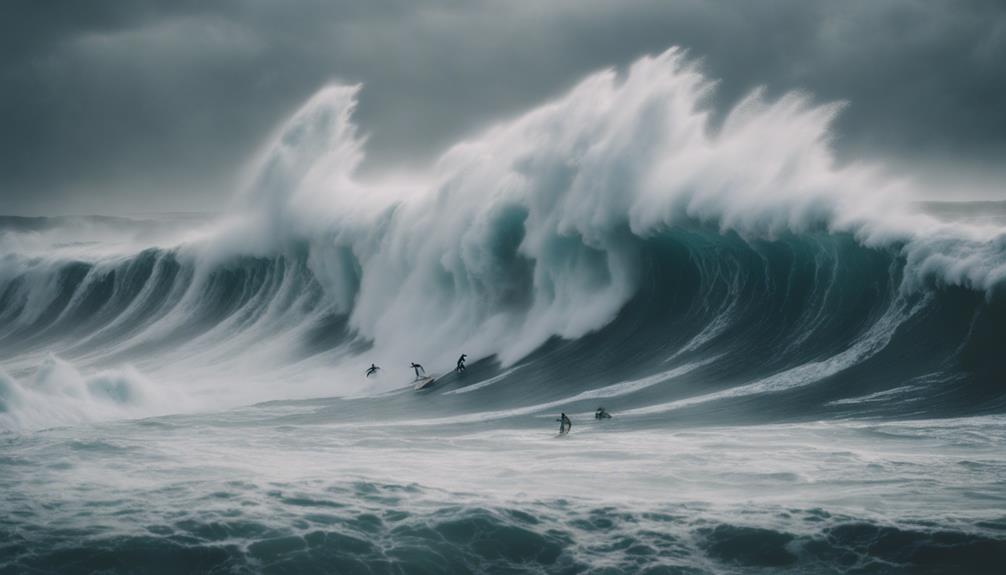
Record holders at Nazaré showcase incredible feats in big wave surfing, with Sebastian Steudtner's astounding 86-foot ride setting the benchmark in 2020. This jaw-dropping record remains unbroken, highlighting the immense challenge of conquering the biggest waves in the world.
Before Steudtner, Garrett McNamara played a pivotal role in popularizing Nazaré as a big wave surfing hotspot. His 78-foot ride on November 1, 2011, opened the door for many surfers to test their limits in these colossal swells. Following McNamara's lead, Rodrigo Koxa made waves of his own when he rode an impressive 80-foot wave on November 8, 2017, marking a significant milestone for Brazilian surfers.
Maya Gabeira made history as the first woman to surf a wave over 70 feet, achieving a remarkable 73-foot ride at Nazaré on February 11, 2020. Justine Dupont also made headlines that same day with her impressive 70.5-foot wave, solidifying her status as a formidable competitor in women's big wave surfing.
These record holders inspire countless surfers to push the boundaries of what's possible in the challenging waters of Nazaré.
Impact of Female Surfers
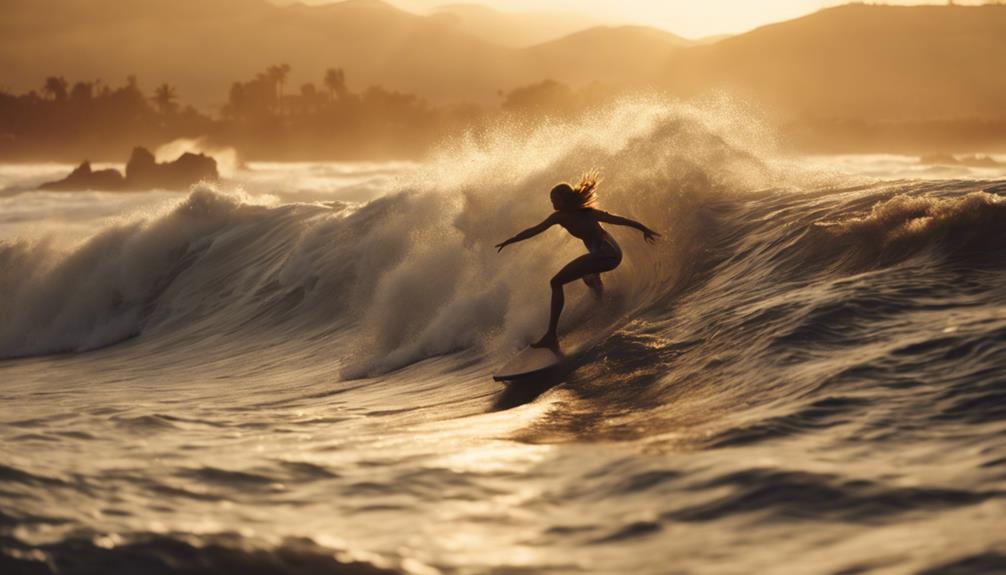
The remarkable achievements of female surfers like Maya Gabeira and Justine Dupont are reshaping the landscape of big wave surfing, showcasing their incredible talent and determination in a traditionally male-dominated sport.
These athletes aren't just riding massive waves; they're also paving the way for future generations and promoting inclusivity within the surfing community.
- Maya Gabeira made history with a 73-foot wave at Nazaré, becoming the first woman to achieve this milestone.
- Justine Dupont further pushed boundaries, riding a 75-foot wave at Cortes Bank in January 2023.
The increasing participation of female surfers in events like the Big Wave Awards reflects a significant shift in the sport.
These women are breaking gender barriers, demonstrating that big wave surfing isn't just for men.
Their accomplishments inspire others and contribute to a broader narrative of diversity and inclusivity.
As you witness these incredible feats, remember that the future of big wave surfing is brighter and more inclusive than ever.
Pioneers of Big Wave Surfing
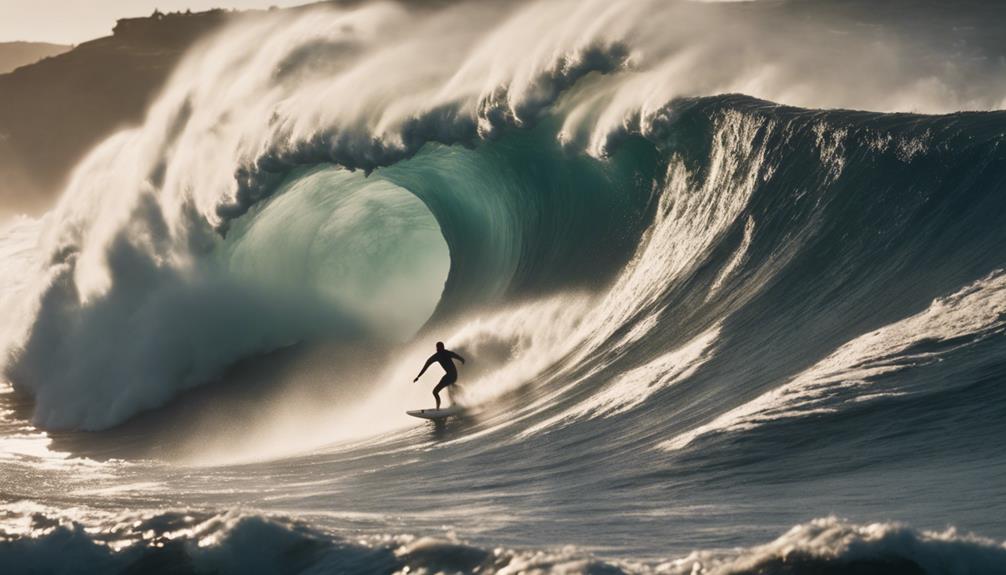
Pioneers like Garrett McNamara and Laird Hamilton have transformed big wave surfing, pushing the boundaries of what's possible and inspiring future generations to chase massive swells.
McNamara's record-breaking ride of a 78-foot wave at Nazaré in 2011 not only popularized this iconic spot but also established it as a mecca for big wave surfers. Meanwhile, Hamilton pioneered tow-in surfing at Jaws in Maui, enabling surfers to tackle even larger waves than traditional paddling allowed.
Adding to this legacy, Sebastian Steudtner set a new benchmark for big wave surfing when he rode an astonishing 86-foot wave at Nazaré on October 29, 2020. His achievement stands as the largest wave ever surfed, showcasing the extreme limits of the sport.
Mike Parsons also made his mark by riding a 77-foot wave at Cortes Bank in 2008, further emphasizing the potential of this lesser-known surf spot.
These individuals exemplify the spirit of pioneering that defines big wave surfing, continuously challenging the limits and encouraging surfers around the world to pursue the thrill of riding monumental waves.
Frequently Asked Questions
Who Surfed the Heaviest Wave Ever?
You'll find that Sebastian Steudtner surfed the heaviest wave ever, measuring 86 feet at Nazaré, Portugal, on October 29, 2020. His incredible feat showcases the thrilling extremes of big wave surfing and ocean challenges.
What Is the Heaviest Wave in the World for Surfing?
Isn't it funny how the heaviest wave ever isn't surfed? While Lituya Bay's monstrous 1,720-foot wave stole the spotlight, the largest wave surfed is an impressive 86 feet at Praia do Norte.
Has Anyone Surfed a 100 Foot Wave?
Yes, Garrett McNamara surfed a 100-foot wave at Nazaré in 2013. While others have claimed similar feats, consistently verifying such extreme waves can be tough, so exact measurements often remain disputed in the surfing community.
What Is the Biggest Wave Ridden by a Man?
The biggest wave you'll find ridden by a man is an astounding 86 feet. Sebastian Steudtner accomplished this feat in Nazaré, Portugal, on October 29, 2020, showcasing incredible skill and determination in big wave surfing.
What Makes Portugal a Hotspot for Heavy Surfing Waves?
Portugal is a hotspot for big surfing waves Portugal, attracting enthusiasts from around the world. The combination of strong Atlantic swells, rocky coastlines, and consistent winds creates ideal conditions for adrenaline-pumping surfing. Additionally, the warm climate and vibrant culture make Portugal a top choice for surfers seeking the ultimate wave-riding experience.
Conclusion
In the world of big wave surfing, every swell tells a story, and you have the chance to be part of it.
From the breathtaking breaks of Nazaré to the fearless pioneers who've carved their names in history, the journey is as thrilling as the ride itself.
Whether you're catching waves or cheering from the shore, the spirit of adventure lives on.
So grab your board, embrace the challenge, and let the ocean's roar ignite your passion for the sport.



